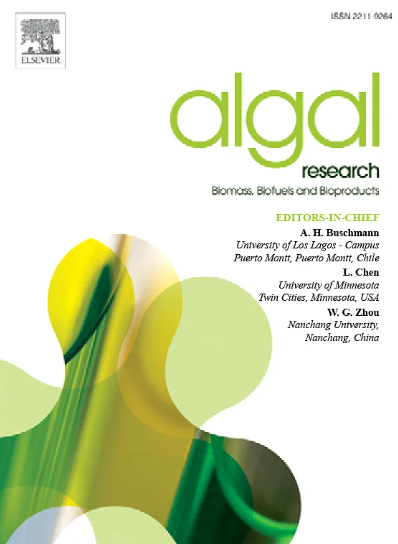海洋纳米绿藻IMET1细胞壁的结构和生化特性及其对酶辅助提取的意义
IF 4.6
2区 生物学
Q1 BIOTECHNOLOGY & APPLIED MICROBIOLOGY
Algal Research-Biomass Biofuels and Bioproducts
Pub Date : 2025-05-28
DOI:10.1016/j.algal.2025.104119
引用次数: 0
摘要
微藻被认为是生产食品、饲料和化妆品原料的潜在可持续原料。然而,坚硬的细胞壁结构对细胞内产物的有效提取提出了重大挑战。酶解细胞壁聚合物可以提供一种温和和环境可持续的细胞破坏方法。然而,对细胞壁结构和建筑特性的不完全了解限制了该方法的商业应用。本研究采用生物化学和显微技术相结合的方法,对Nannochloropsis oceanica IMET1细胞壁的组成、形貌、超微结构和结构进行了分析。提取的细胞壁经酸水解释放出中性糖,占其总重量的80% (w/w)。在这些糖中,64%是葡萄糖,它主要构成纤维素层。通过扫描共聚焦显微镜的钙荧光白荧光成像进一步证实了这一点。此外,少量阿拉伯糖、焦糖、半乳糖和甘露糖的存在表明存在连接外层、纤维素基层和质膜的多糖网络。扫描电镜显示,荧光凝集素染色证实,细胞表面覆盖着n -乙酰氨基葡萄糖单元。透射电镜显示双层细胞壁结构。用地衣酶和纤维素酶水解提取的细胞壁,产生的大部分是葡萄糖单体,同时还有少量的其他中性糖。总的来说,本研究提供了对N. oceanica IMET1细胞壁复杂结构的深入了解,可以提高微藻酶辅助提取策略。本文章由计算机程序翻译,如有差异,请以英文原文为准。
Structural and biochemical characterization of Nannochloropsis oceanica IMET1 cell wall and its implications for enzyme-assisted extraction
Microalgae are considered a potential sustainable feedstock for producing ingredients used in food, feed and cosmetics. However, the rigid cell wall structure presents a significant challenge for the efficient extraction of intracellular products. Enzymatic hydrolysis of cell wall polymers could offer a mild and environmentally sustainable cell disruption approach. Nevertheless, incomplete knowledge of the structural and architectural properties of the cell wall limits the commercial application of this method. In this study, a combination of biochemical and microscopy techniques was used to decipher the composition, topography, ultrastructure and the architecture of the cell wall of Nannochloropsis oceanica IMET1. Acid hydrolysis of the extracted cell wall released neutral sugars, constituting 80 % of its total weight (w/w). Of these sugars, 64 % was glucose, which primarily constitutes the cellulose layer. This was further confirmed through calcofluor white fluorescence imaging using a scanning confocal microscope. Additionally, the presence of small amounts of arabinose, fucose, galactose, and mannose suggests the presence of polysaccharide networks connecting the outer layer, the cellulose-based layer and the plasma membrane. Scanning electron microscopy revealed a rugged cell surface covered with N-acetyl-glucosamine units as confirmed by fluorescent-lectin staining. Transmission electron microscopy revealed a double-layered cell wall structure. Hydrolysis of the extracted cell wall with lichenases and cellulases generated mostly glucose monomers alongside traces of other neutral sugars. Overall, this study provides insights into the complex structure of the cell wall of N. oceanica IMET1, which can enhance enzyme assisted extraction strategies in microalgae.
求助全文
通过发布文献求助,成功后即可免费获取论文全文。
去求助
来源期刊

Algal Research-Biomass Biofuels and Bioproducts
BIOTECHNOLOGY & APPLIED MICROBIOLOGY-
CiteScore
9.40
自引率
7.80%
发文量
332
期刊介绍:
Algal Research is an international phycology journal covering all areas of emerging technologies in algae biology, biomass production, cultivation, harvesting, extraction, bioproducts, biorefinery, engineering, and econometrics. Algae is defined to include cyanobacteria, microalgae, and protists and symbionts of interest in biotechnology. The journal publishes original research and reviews for the following scope: algal biology, including but not exclusive to: phylogeny, biodiversity, molecular traits, metabolic regulation, and genetic engineering, algal cultivation, e.g. phototrophic systems, heterotrophic systems, and mixotrophic systems, algal harvesting and extraction systems, biotechnology to convert algal biomass and components into biofuels and bioproducts, e.g., nutraceuticals, pharmaceuticals, animal feed, plastics, etc. algal products and their economic assessment
 求助内容:
求助内容: 应助结果提醒方式:
应助结果提醒方式:


